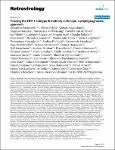Tracing the HIV-1 subtype B mobility in Europe: a phylogeographic approach
Paraskevis, Dimitrios
Pybus, Oliver
Magiorkinis, Gkikas
Hatzakis, Angelos
Wensing, Annemarie M. J.
Vijver, David A. M. C. van de
Albert, Jan
Angarano, Guiseppe
Hamouda, Osamah
Balotta, Claudia
Boeri, Enzo
Camacho, Ricardo
Background: The prevalence and the origin of HIV-1 subtype B, the most prevalent circulating clade among the long-term residents in Europe, have been studied extensively. However the spatial diffusion of the epidemic from the perspective of the virus has not previously been traced. Results: In the current study we inferred the migration history of HIV-1 subtype B by way of a phylogeography of viral sequences sampled from 16 European countries and Israel. Migration events were inferred from viral phylogenies by character reconstruction using parsimony. With regard to the spatial dispersal of the HIV subtype B sequences across viral phylogenies, in most of the countries in Europe the epidemic was introduced by multiple sources and subsequently spread within local networks. Poland provides an exception where most of the infections were the result of a single point introduction. According to the significant migratory pathways, we show that there are considerable differences across Europe. Specifically, Greece, Portugal, Serbia and Spain, provide sources shedding HIV-1; Austria, Belgium and Luxembourg, on the other hand, are migratory targets, while for Denmark, Germany, Italy, Israel, Norway, the Netherlands, Sweden, Switzerland and the UK we inferred significant bidirectional migration. For Poland no significant migratory pathways were inferred. Conclusion: Subtype B phylogeographies provide a new insight about the geographical distribution of viral lineages, as well as the significant pathways of virus dispersal across Europe, suggesting that intervention strategies should also address tourists, travellers and migrants.
No license information

